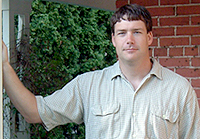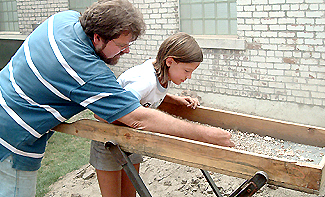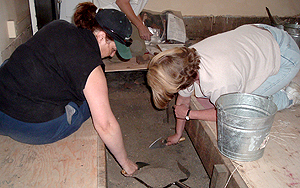
|
CONNECTIONS
|
IDAHO
ITD
HOME
IDAHO DMV
ITD NEWS
HIGHWAY
SAFETY
IDAHO STATE
POLICE
TRAVEL SERVICES
STATE OF IDAHO
NATIONAL
AASHTO
AAMVA
AAA of IDAHO
FEDERAL HIGHWAYS
FEDERAL AVIATION
IDAHO STATE POLICE
NHTSA
NTSB
TRB
U.S. DOT
Idaho
Transportation
Department
Public Affairs Office
P.O. Box 7129
Boise, ID 83707
208.334.8005
Fax: 208.334.8563
Email

ITD
archaeologist helps recover pieces
of historic Basque House's past
Historians have wondered what “if these walls could talk...” The walls of the Basque House in downtown Boise remain silent, but the floors are speaking volumes.
 When
directors of the Basque Museum and Cultural Center launched a restoration
project for the 140-year-old building, they began with the foundation,
which meant tearing off floor boards. That process served as a gateway
to exploration, revealing a wealth of artifacts on the ground and buried
just below the surface.
When
directors of the Basque Museum and Cultural Center launched a restoration
project for the 140-year-old building, they began with the foundation,
which meant tearing off floor boards. That process served as a gateway
to exploration, revealing a wealth of artifacts on the ground and buried
just below the surface.
Enter Marc Munch, president of the Idaho Archaeological Society (IAS) and a transportation archaeologist for ITD. Rather than referring the Basque House leaders to a costly private consultant, when asked for advice, Munch offered his services and those of the archaeological society.
For the price of soft drinks, bottled water, occasional snacks and a small donation to the IAS, the cultural center received nearly 1,000 hours of volunteer digging and documentation spread over six consecutive weekends.
The dedicated corps ranged from children to retirees – a librarian, a geologist, real estate professionals, and archaeological society members who, in paid positions, work for the Bureau of Land Management, U.S. Forest Service, Army National Guard and ITD. Theirs was a labor of love – and curiosity– from 9 a.m. to 4 p.m. on weekends.
The exploration and inventory process concluded July 11; Munch’s analysis of the results should be finished in two or three months.
 Volunteers
found about what you’d expect to find in the bowels of the city’s
oldest surviving brick building. Square-cut nails and glass beads. A
fork and spoon. Cigarette rolling papers and women’s hair pins.
Seeds, pits and shells. Broken glass and ceramic marbles. Fragments
of dishes and coins (pennies dated 1892, 1912 and 1918).
Volunteers
found about what you’d expect to find in the bowels of the city’s
oldest surviving brick building. Square-cut nails and glass beads. A
fork and spoon. Cigarette rolling papers and women’s hair pins.
Seeds, pits and shells. Broken glass and ceramic marbles. Fragments
of dishes and coins (pennies dated 1892, 1912 and 1918).
And a plethora of buttons made of metal, shells and ceramic, some with two holes, some with four and others with a single wire loop in back.
Their true significance lies not in monetary value, but in the stories they tell. You can envision a woman sewing buttons on a dress near the parlor fireplace. A child playing marbles on the floor. A broken serving dish whose tiny pieces escaped to the earth below. Cigarette papers slipping through the cracks. Hair pins lost from nightly grooming in front of a mirror in the bedroom.
“What does that mean?” Munch asks, rhetorically. “What do these artifacts tell you? You can start to see the kinds of activities that took place in the bedroom and the parlor…
“They’re giving us insight into the lives of those who lived in the house… the Jacobs (Cyrus and Mary), and all of the boarders who lived there. By doing the excavation and recovering the artifacts and analyzing the artifacts, we develop a tangible connection between the past and the present.”
Spoken like the true anthropologist that he is.
Munch holds a master’s degree in anthropology from the University of Montana (2003) and a bachelor’s in the same discipline from Boise State University (1994). Before joining ITD as a transportation archaeologist in 2003, he was held a similar position with the Boise National Forest for nine years.
In his day job, Munch and colleague Dan Gant look for cultural and historical sites that could be impacted by highway and bridge construction. The goal is to preserve and protect structures and sites that have cultural, historic or prehistoric significance... that afford critical vignettes of Idaho’s past.
The most recent discovery was of a Native American work camp next to a U.S. 12 passing lane project east of Lewiston. ITD contracted with a team of independent archaeologists to sift through soil for artifacts such as projectile (arrow) points and fire-cracked rock and flakes from tool-making.
 Their
work revealed a wealth of buried treasure dating back more than 10,000
years – the oldest work site now documented along the pristine
Clearwater River. Led by Lee Sappington of the University of Idaho,
the group recently finished its extensive work at milepost 31 and moved
to another site 22 miles to the east.
Their
work revealed a wealth of buried treasure dating back more than 10,000
years – the oldest work site now documented along the pristine
Clearwater River. Led by Lee Sappington of the University of Idaho,
the group recently finished its extensive work at milepost 31 and moved
to another site 22 miles to the east.
“Federal requirements mandate that cultural investigations be done on all projects that involve federal funding,” Munch explains. “We also have our own (state) requirements for projects that aren’t federally funded. We find cultural elements on about 20 percent of the projects and historic artifacts on about 50 percent.”
Those discoveries provide a tangible link to Idaho’s rich past – from the Native Americans who first called the region home and the Chinese immigrants who worked the mines of north and central Idaho, to the Basques who herded sheep on the arid planes of southwest Idaho.
Basques found the region strikingly similar to the land they left behind in Spain. Many had ambitions of working in America, saving as much money as possible and returning to their native land.
When harsh winter weather chased them from the desert, they congregated in Boise, taking up residence in about a dozen Basque boarding houses that comprised the Basque Block. Among the buildings was the home of Cyrus and Mary Jacobs who were some of Boise’s earliest pioneers.
They built the home in 1864 and occupied it until 1910 when it was converted into a boarding house. Several families managed the boarding house until 1928 when Jose and Hermenegilda Uberuaga bought it. They operated the boarding house until 1969.
The original home and an 1878 addition that nearly doubled the floor space to about 2,000 square feet will become a Basque cultural/educational center. A large representation of the 5,000 artifacts unearthed from beneath the building will be displayed at the house.
Many items held by the Jacobs’ descendants and others who lived in the house have been donated to the center and will be included in educational displays.
One of the most interesting discoveries during the renovation process is a small fireplace covered by a wall. When floor boards were removed, a distinct charred arch was found, indicating that fire had escaped from the shallow fireplace. Rather than risking another – perhaps more devastating fire – occupants chose to build a plaster wall over the fireplace.
Munch hopes to complete his documentation of the artifacts in the next two months. If renovations proceed as planned, the center could open in July 2005, coinciding with the traditional week-long Jaialdi festival of Spanish dance and music.
Note: This story was suggested by Pat Williams, management assistant, Division of Highways. If you have an idea for a Transporter feature about one of your ITD colleagues, please forward it to Transporter Feature File.
| TRANSPORTER HOME | MILESTONES | ARCHIVES |